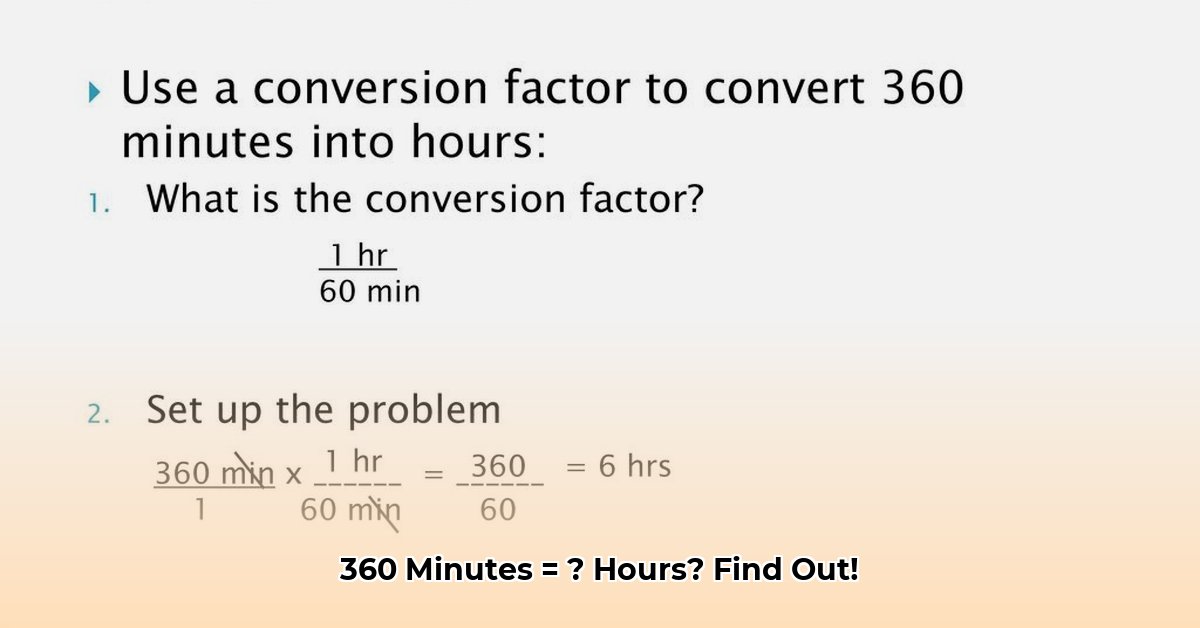Ever found yourself wondering, “How many hours are there in 360 minutes?” It’s a common question, and the answer is simpler than you might think! Need help with other time conversions? Check out this helpful guide on converting days to weeks. This guide provides a clear, step-by-step explanation of how to convert minutes to hours, enhancing your ability to manage time effectively in everyday situations. We’ll also explore the fascinating history of time measurement.
Understanding the Minute-to-Hour Relationship: A Key to Time Management
Understanding how minutes relate to hours is a fundamental skill for efficient time management. Let’s break down the conversion process step-by-step.
Minutes and Hours: The Basic Building Blocks
Before diving into the conversion, let’s solidify the basics: An hour is a unit of time comprised of 60 minutes. Knowing this foundational relationship is crucial.
Converting 360 Minutes to Hours: A Simple Calculation
Converting 360 minutes into hours involves a straightforward calculation. We need to determine how many times 60 minutes (the length of one hour) fits into 360 minutes.
Step 1: Start with the Given Value. Our starting point is 360 minutes.
Step 2: Apply the Conversion Factor. The conversion factor is based on the fact that 1 hour equals 60 minutes. Thus, we must divide.
Step 3: Perform the Division. Divide the total number of minutes (360) by the number of minutes in an hour (60): 360 ÷ 60 = 6.
Result: 360 minutes is equivalent to 6 hours.
Visualizing the Duration: The Analogy of a Clock
Consider a clock face; visualize the minute hand moving from the starting point until it has completed a full rotation six times. Each complete rotation represents an hour, and six rotations equal six hours, making it a visual confirmation that 360 minutes equals six hours.
A Brief History of Minutes and Hours
Dividing time into hours and minutes has ancient roots. The concept of dividing the day into smaller units dates back to ancient civilizations, such as the Egyptians and Babylonians. However, the standardization of the 60-minute hour is a more recent development, evolving alongside advancements in timekeeping technology.
Practical Applications in Everyday Life
Converting minutes to hours is not just a theoretical exercise; it has numerous practical applications: planning trips, scheduling meetings, calculating work hours, timing recipes, and more.
Common Conversion Errors: How to Avoid Them
A common mistake is using the wrong conversion factor or performing the wrong operation (multiplying instead of dividing). Always double-check that you are dividing the total minutes by 60. Calculators can help, but understanding the underlying process ensures accuracy.
Converting Other Values: Beyond 360 Minutes
The same principle applies to any number of minutes. For example, to convert 450 minutes to hours, divide 450 by 60. The result is 7.5 hours. The whole number (7) represents the complete hours, and the decimal (0.5) represents a fraction of an hour. To convert the decimal portion back into minutes, multiply 0.5 by 60, which equals 30 minutes. Therefore, 450 minutes is equal to 7 hours and 30 minutes.
Test Your Understanding: A Quick Quiz
- How many hours are there in 180 minutes?
- A movie is 150 minutes long. How many hours is that?
Answer Key:
- 3 hours
- 2.5 hours (2 hours and 30 minutes)
Converting minutes to hours is a simple skill with widespread applications. Whether it’s for planning, scheduling, or simply understanding the passage of time, this conversion is a useful tool in everyday life.
Accurate Minute to Hour Conversion: A Deeper Dive into Time Calculations
Key Points:
- One hour contains 60 minutes: the core relationship for conversion.
- Divide minutes by 60 to obtain hours.
- Apply to scheduling and trip planning.
- Essential for precision.
- Check answers to avoid errors.
Mastering the Fundamentals: Minutes to Hours
Every hour consists of 60 minutes. It’s important to understand that 60 minutes equals 1 hour.
The Conversion Process: Division Demystified
To easily convert minutes to hours, divide the minute count by 60. The result will be the equivalent time span expressed in hours.
If you wanted to convert 150 minutes to hours, you’d divide 150 by 60, giving an answer of 2.5 hours. Easy to understand?
Step-by-Step: Converting 360 Minutes
Let’s convert 360 minutes to hours. Here’s how we can do it:
- Write down the equation: 360 minutes / 60 minutes/hour
- Solve: 360 / 60 = 6
- Provide the definitive answer: 360 minutes is the same as 6 hours.
This method of calculation remains constant regardless of the minute value you’re converting.
Decimal Hour Representation: The Power of Precision
Scientific and technical contexts often use decimal values for greater precision. If you divide 390 minutes by 60, you get 6.5 hours. In this case the .5 stands for one half of an hour, equaling 30 minutes.
Converting Large Minute Values to Hours for Scientific Applications
When working with large numbers, use a calculator or spreadsheet to increase efficiency and accuracy. Spreadsheets make calculating complex equations, like “how to accurately convert large minute values to hours for scientific applications”, much easier and limit errors. Confirm the calculator’s accuracy and that you have correctly inputted the equation.
A Glimpse into the Past: The History of Time
The practice of splitting the hour into 60 minutes is derived from the Babylonian base-60 system. This mathematical influence from ancient society continues to impact how we measure time today.
Real-World Implications: Why Conversions Matter
The skill of converting minutes to hours goes beyond mere mathematical exercise. It is important in many areas:
- Research: Critical in monitoring test durations and assessing data recorded over time.
- Managing Projects: It is useful for calculating project timelines and arranging milestones.
- Medical field: Helpful for following patient care plans, tracking medication schedules, etc.
- Salary Administration: Calculating employee hours and figuring out overtime.
Minute-to-hour conversion is more relevant to our lives than people might assume.
Avoidance and Troubleshooting of Typical Mistakes
The most frequent error involves forgetting to divide by 60. Always re-check your work.
- Discover Fermentation Revolution: The Health Benefits of Kimchi: Sustainable Farming Practices - July 30, 2025
- Discover Living Crystals: The Giant Gypsum Formations in Naica’s Cave: A Geological Marvel - July 30, 2025
- Master Molecular Gastronomy: The Science That Turns Your Kitchen into a Lab: Beginner-Friendly Recipes - July 30, 2025
















